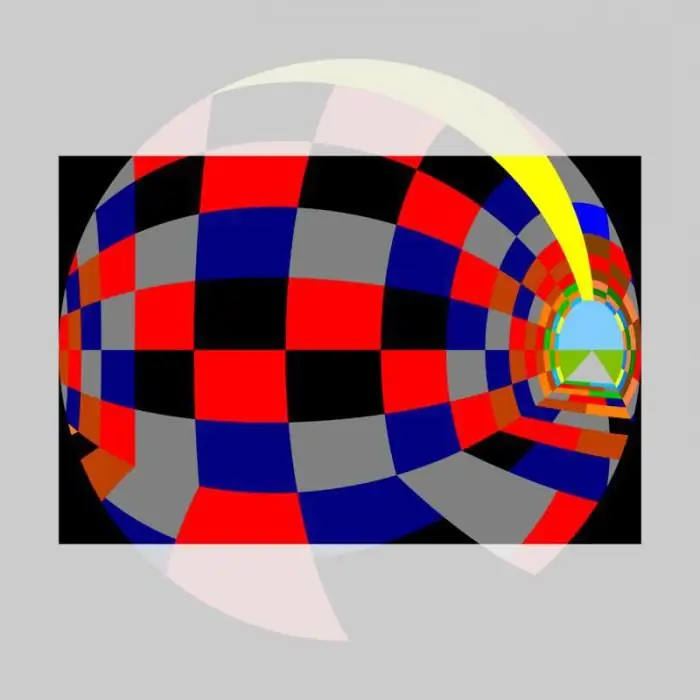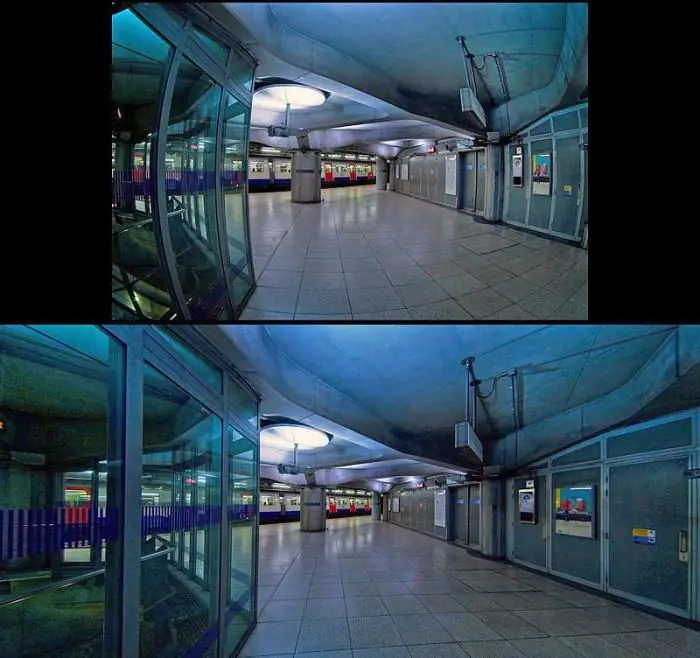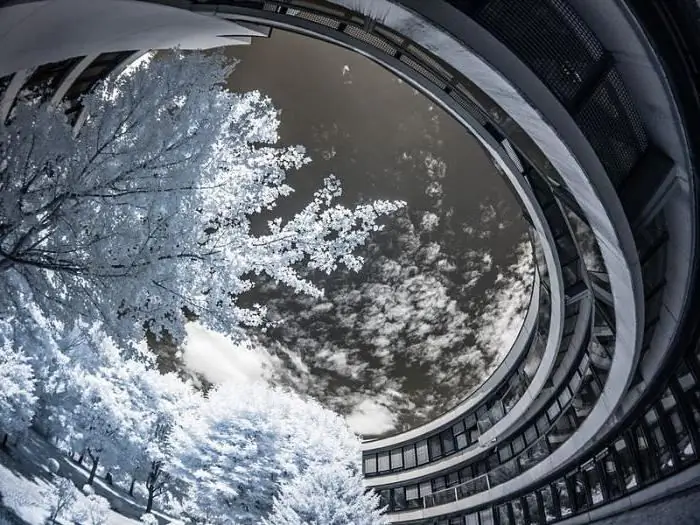
Inhaltsverzeichnis:
- Autor Sierra Becker [email protected].
- Public 2024-02-26 04:43.
- Zuletzt bearbeitet 2025-06-01 05:43.
Verzeichnung ist ein Fehler oder Fehler in der Kombination optischer Elemente, bei dem sich der lineare Vergrößerungsfaktor über das Sichtfeld des Objektivs ändert.
Verzerrung definieren
Verzerrung wird aus dem Lateinischen mit "Krümmung" übersetzt. Bei der Verzerrung wird die Ähnlichkeit zwischen dem Objekt und seinem visuellen Bild verletzt. Verzerrung ist ein Fehler. Es kann bei der Auswahl eines optischen Systems bei der Auswahl von Objektiven oder bei der Bearbeitung eines Fotos auf einem PC korrigiert werden. Verzerrung ist ein wahrnehmbares Phänomen, wenn im Rahmen gerade horizontale oder vertikale Linien vorhanden sind. Durch die Verzerrung werden gerade Linien nach außen oder in das Bild hinein gekrümmt. Es wird beim Fotografieren architektonischer Gebäude, Bäume, Stangen und anderer Objekte ausgesprochen.
Arten von Verzerrungen
Verzerrung tritt in zwei Arten auf - sie ist tonnenförmig und kissenförmig.
Tonnen- oder Wölbungsverzerrung zeichnet sich dadurch aus, dass die Krümmung der Linie nach außen gerichtet ist, während das Objekt konvex wird, was relativ zu den Bildrändern sehr auffällig ist.

Die kissenförmige oder konkave Verzerrung zeichnet sich durch eine Krümmung der Linie näher an der Bildmitte aus, dh die Linien erscheinen konkavinnerhalb des Bildes.
Tonnenverzeichnung wird auch als positiv und Kissenverzeichnung als negativ bezeichnet.
Verzerrung beim Aufnehmen
Der Grund für die Kameraverzerrung kann im Objektiv Ihrer Kamera liegen. Wenn es klarer ist, dies offenzulegen, dann kann festgestellt werden, dass bei Verwendung billiger Objektive, deren Qualität angezweifelt werden kann, das Bild verzerrt wird. Dies ist meistens bei Objektiven der Fall, die als "Zoomobjektiv" bezeichnet werden, sie haben eine variable Brennweite, weshalb Verzerrungen auftreten.
Der zweite Grund liegt im Moment des Fotografierens - das ist das Zusammenlaufen parallel zueinander verlaufender Linien in Schräglage oder wenn sich der Fotograf selbst anlehnt. Dies passiert meistens, wenn hohe Gebäude aus einem niedrigen Winkel aufgenommen werden.

Um Verzerrungen beim Fotografieren zu vermeiden, können Sie ein paar einfache Regeln anwenden:
- kauf ein hochwertiges Objektiv, vorzugsweise ein Weitwinkelobjektiv;
- entferne dich vom Objekt und bringe es beim Fotografieren näher heran.
Wenn diese beiden einfachen Regeln nicht geholfen haben, können Bildbearbeitungsprogramme dieses Problem lösen. Das geht ganz einfach.
Verzerrungskorrektur während der Bearbeitung
Wenn die Verzerrung subtil ist, kann sie beim Herunterladen der Adobe Camera Raw-Tools mit dem Adobe Lens Profile Downloader entfernt werden. Öffnen Sie das Programm Adobe Camera Raw, klicken Sie auf das Bild, das Sie bearbeiten möchten. Gehen Sie zur Registerkarte Linsenkorrekturen und aktivieren Sie das Linsenprofil durch Einstellungaktivieren Sie Linsenprofilkorrekturen aktivieren.
Zuerst müssen Sie ein Foto in diesem Programm öffnen und zum Abschnitt Objektivkorrekturen gehen, dann Manuell auswählen, dort sehen Sie Positionen wie Verzerrung, Vertikal, Drehen und andere. Es ist notwendig, den Verzerrungsregler so weit wie nötig auf Minus zu schieben, um die Verzerrung vollständig zu beseitigen.

„Aber wie korrigiert man Verzerrungen in Photoshop? - fragen Sie. Ja, ganz einfach! Öffnen Sie zuerst das Bild in Adobe Photoshop, dann die Registerkarte „Filter“und wählen Sie „Objektivkorrekturen“. Es öffnet sich ein Fenster, und Sie müssen Öffnen Sie die Registerkarte Benutzerdefiniert und verschieben Sie dann den charakteristischen Schieberegler namens Verzerrung entfernen auf einen positiven Wert, bis die Verzerrung vollständig korrigiert ist.
Absichtliche Verzerrung
Fotografen betrachten Verzerrungen nicht immer als fotografischen Fehler, einige versuchen, sie absichtlich mit einem Objektiv oder bei der Bearbeitung eines Fotos in einem Editor zu erzeugen.
Was das Objektiv betrifft, so ist "Fisheye" oder wie es auch "Fisheye" genannt wird, sehr verbreitet. Dies ist eine Art sogenanntes Ultraweitwinkelobjektiv, das eine konvexe Frontlinse bei 180 Grad hat, was zu Verzerrungen in den Bildern führt. Es gibt zwei Arten von Fisheye-Objektiven: kreisförmig und diagonal. Die kreisförmige Linse wird am häufigsten in der Meteorologie verwendet, um Himmelsaufnahmen zu machen. Das Diagonalobjektiv ist unter Fotografen am weitesten verbreitet. Wir kennen sogar den Namen des ersten Fotografen, der zum ersten Mal verwendet hatdieser Typ. Das ist Lev Abramovich Borodulin, ein bekannter sowjetischer und israelischer Sportfotograf.

Es gibt eine Reihe anderer Objektive, aber sie zielen alle darauf ab, Bildverzerrungen zu erzeugen. Solche Geräte sind bei Nikon, Canon und anderen Kameraherstellern zu finden.
Sie können in "Photoshop" absichtlich Verzerrungen vornehmen, dazu müssen Sie das gewünschte Bild öffnen, es auswählen und zur Registerkarte "Bearbeiten" gehen, dann müssen Sie die Funktion "Transformieren" auswählen, eine Nummer dort weitere Funktionen erscheinen, sollten Sie „Verformung“auswählen. Ihr Bild wird auf dem Raster platziert, wo Sie arbeiten müssen. Ziehen Sie das Bild wie gewünscht.
Schlussfolgerung
Trotz der Tatsache, dass Verzerrungen meistens negativ wahrgenommen werden, wird dieser Effekt in einigen Fällen absichtlich eingesetzt, um die Aufmerksamkeit auf einen bestimmten Moment oder Teil eines Objekts zu lenken. Dieser Effekt wird seit langem in der Fotoindustrie verwendet, ist aber erst seit relativ kurzer Zeit sehr beliebt.

Distortion ist die Art und Weise eines Fotografen, sich auszudrücken, eine Gelegenheit, seine Individualität zu zeigen. Es verleiht dem Bild einen besonderen Glanz und Spezifität. Heutzutage beginnen immer mehr Fotografen auf der ganzen Welt, eng mit diesem Effekt zu arbeiten und die Möglichkeiten der Verzerrung voll auszunutzen. Natürlich nicht alle Profis, undnormale Menschen mögen Fotos, die mit diesem Effekt aufgenommen wurden, aber es hat keinen Sinn, die Tatsache zu leugnen, dass das Interesse an Verzerrungen in den letzten Jahren stark zugenommen hat, da es offensichtlich ist.
Empfohlen:
Vignettierung - was ist das in der Fotografie? künstlerische Fotografie

Es gibt unzählige Möglichkeiten, das Wichtigste im Rahmen hervorzuheben. Dazu können Sie verschiedene Licht- und Farbmethoden verwenden oder sich auf Linien und Rahmen konzentrieren. Aber der einfachste und schnellste Weg zur Auswahl ist die Vignettierung. Was ist das? In unserem Artikel werden wir diese Frage ausführlich beantworten
Ein ungewöhnliches Ding ist eine Dose. Ungewöhnliche Dinge mit eigenen Händen

Glasbehälter, allgemein als Krug bezeichnet, kann mit seinem minimalistischen Design und seinen prägnanten Formen zu Recht als Muse der Kreativität bezeichnet werden. Banken sind so einfach, dass Sie etwas Schönes auf ihren transparenten Seiten schaffen möchten. Lassen wir die Gedanken über den direkten Zweck der Gefäße beiseite und betrachten eine Reihe von Verwandlungen dieser Geschirr-Aschenputtel in wundervolle Prinzessinnen
Fang an zu häkeln. Ist es besser für ein Mädchen, ein Oberteil oder ein Sommerkleid zu wählen?

Anfängerinnen sind bei der Auswahl des ersten Modells oft verwirrt: Was soll man wählen? Versuchen Sie, ein Sommerkleid für ein Mädchen zu häkeln oder zu stricken
Schach: Geschichte, Terminologie. Das Leben ist ein Spiel: Zugzwang ist eine zusätzliche Motivation, kein Ende

Schach und Dame sind eines der beliebtesten modernen Spiele. Es ist schwierig, einen modernen Menschen zu finden, der noch nie in seinem Leben Figuren auf einer Schwarz-Weiß-Tafel bewegt und dabei raffinierte Manöver durchgedacht hat. Aber nur wenige Menschen, abgesehen von professionellen Spielern, sind mit der Schachterminologie vertraut. Diese Konzepte werden jedoch häufig verwendet, um reale Ereignisse des öffentlichen Lebens zu beschreiben. "Zugzwang" ist so ein Begriff
Was ist "Equivok" - ist es ein Spiel oder eine List?

Praktisch jeder gebildete Mensch hat schon einmal das Wort "equivoki" gehört. Wussten Sie, dass „Equipment“heute nicht nur Archaismus, sondern auch große Unterh altung für Witzige und Gelehrte ist?
